fuel pressure BMW 640I CONVERTIBLE 2013 Owners Manual
[x] Cancel search | Manufacturer: BMW, Model Year: 2013, Model line: 640I CONVERTIBLE, Model: BMW 640I CONVERTIBLE 2013Pages: 240, PDF Size: 9.64 MB
Page 105 of 240
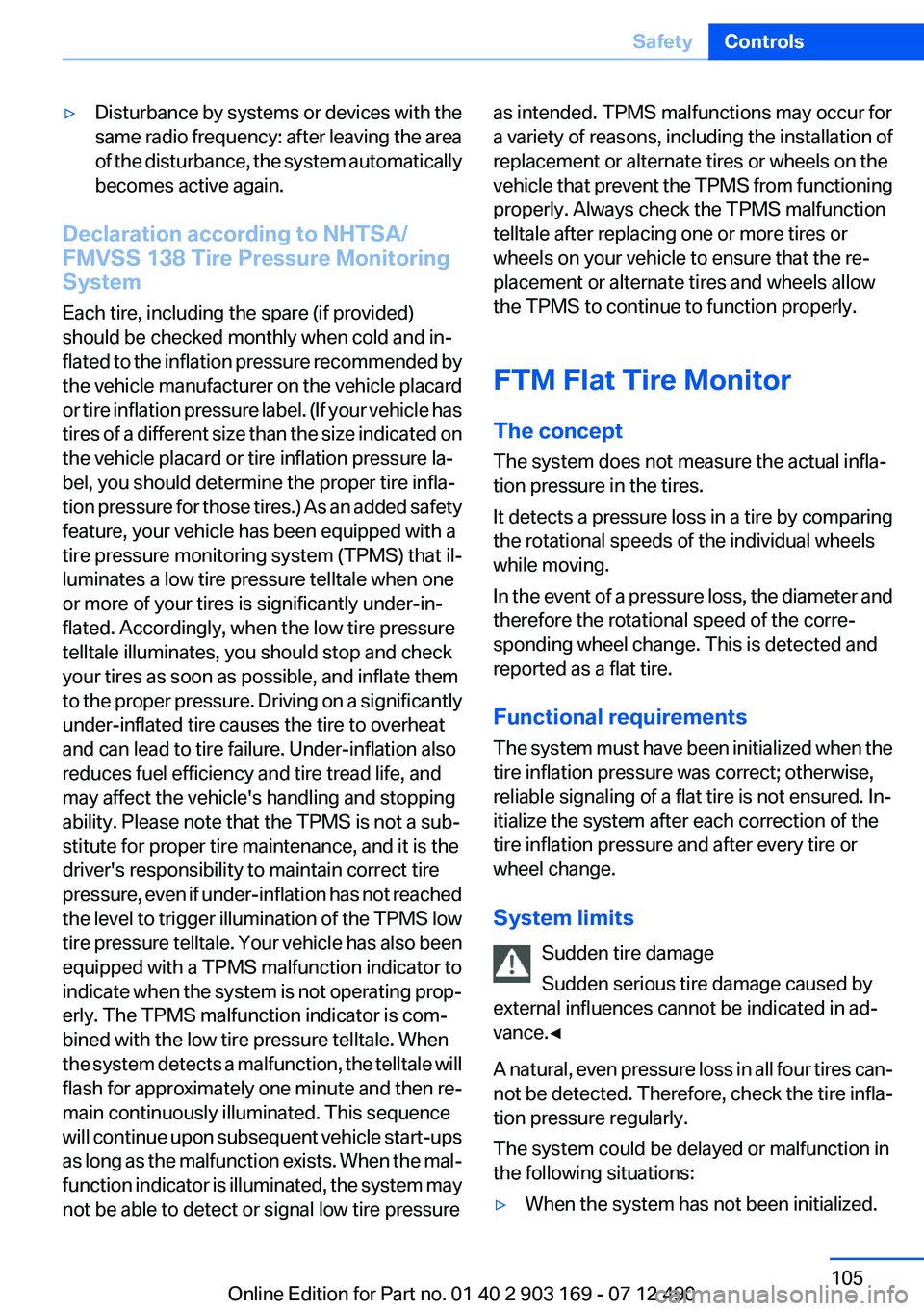
▷Disturbance by systems or devices with the
same radio frequency: after leaving the area
of the disturbance, the system automatically
becomes active again.
Declaration according to NHTSA/
FMVSS 138 Tire Pressure Monitoring
System
Each tire, including the spare (if provided)
should be checked monthly when cold and in‐
flated to the inflation pressure recommended by
the vehicle manufacturer on the vehicle placard
or tire inflation pressure label. (If your vehicle has
tires of a different size than the size indicated on
the vehicle placard or tire inflation pressure la‐
bel, you should determine the proper tire infla‐
tion pressure for those tires.) As an added safety
feature, your vehicle has been equipped with a
tire pressure monitoring system (TPMS) that il‐
luminates a low tire pressure telltale when one
or more of your tires is significantly under-in‐
flated. Accordingly, when the low tire pressure
telltale illuminates, you should stop and check
your tires as soon as possible, and inflate them
to the proper pressure. Driving on a significantly
under-inflated tire causes the tire to overheat
and can lead to tire failure. Under-inflation also
reduces fuel efficiency and tire tread life, and
may affect the vehicle's handling and stopping
ability. Please note that the TPMS is not a sub‐
stitute for proper tire maintenance, and it is the
driver's responsibility to maintain correct tire
pressure, even if under-inflation has not reached
the level to trigger illumination of the TPMS low
tire pressure telltale. Your vehicle has also been
equipped with a TPMS malfunction indicator to
indicate when the system is not operating prop‐
erly. The TPMS malfunction indicator is com‐
bined with the low tire pressure telltale. When
the system detects a malfunction, the telltale will
flash for approximately one minute and then re‐
main continuously illuminated. This sequence
will continue upon subsequent vehicle start-ups
as long as the malfunction exists. When the mal‐
function indicator is illuminated, the system may
not be able to detect or signal low tire pressure
as intended. TPMS malfunctions may occur for
a variety of reasons, including the installation of
replacement or alternate tires or wheels on the
vehicle that prevent the TPMS from functioning
properly. Always check the TPMS malfunction
telltale after replacing one or more tires or
wheels on your vehicle to ensure that the re‐
placement or alternate tires and wheels allow
the TPMS to continue to function properly.
FTM Flat Tire Monitor
The concept
The system does not measure the actual infla‐
tion pressure in the tires.
It detects a pressure loss in a tire by comparing
the rotational speeds of the individual wheels
while moving.
In the event of a pressure loss, the diameter and
therefore the rotational speed of the corre‐
sponding wheel change. This is detected and
reported as a flat tire.
Functional requirements
The system must have been initialized when the
tire inflation pressure was correct; otherwise,
reliable signaling of a flat tire is not ensured. In‐
itialize the system after each correction of the
tire inflation pressure and after every tire or
wheel change.
System limits Sudden tire damage
Sudden serious tire damage caused by
external influences cannot be indicated in ad‐
vance.◀
A natural, even pressure loss in all four tires can‐
not be detected. Therefore, check the tire infla‐
tion pressure regularly.
The system could be delayed or malfunction in
the following situations:▷When the system has not been initialized.Seite 105SafetyControls105
Online Edition for Part no. 01 40 2 903 169 - 07 12 490
Page 169 of 240
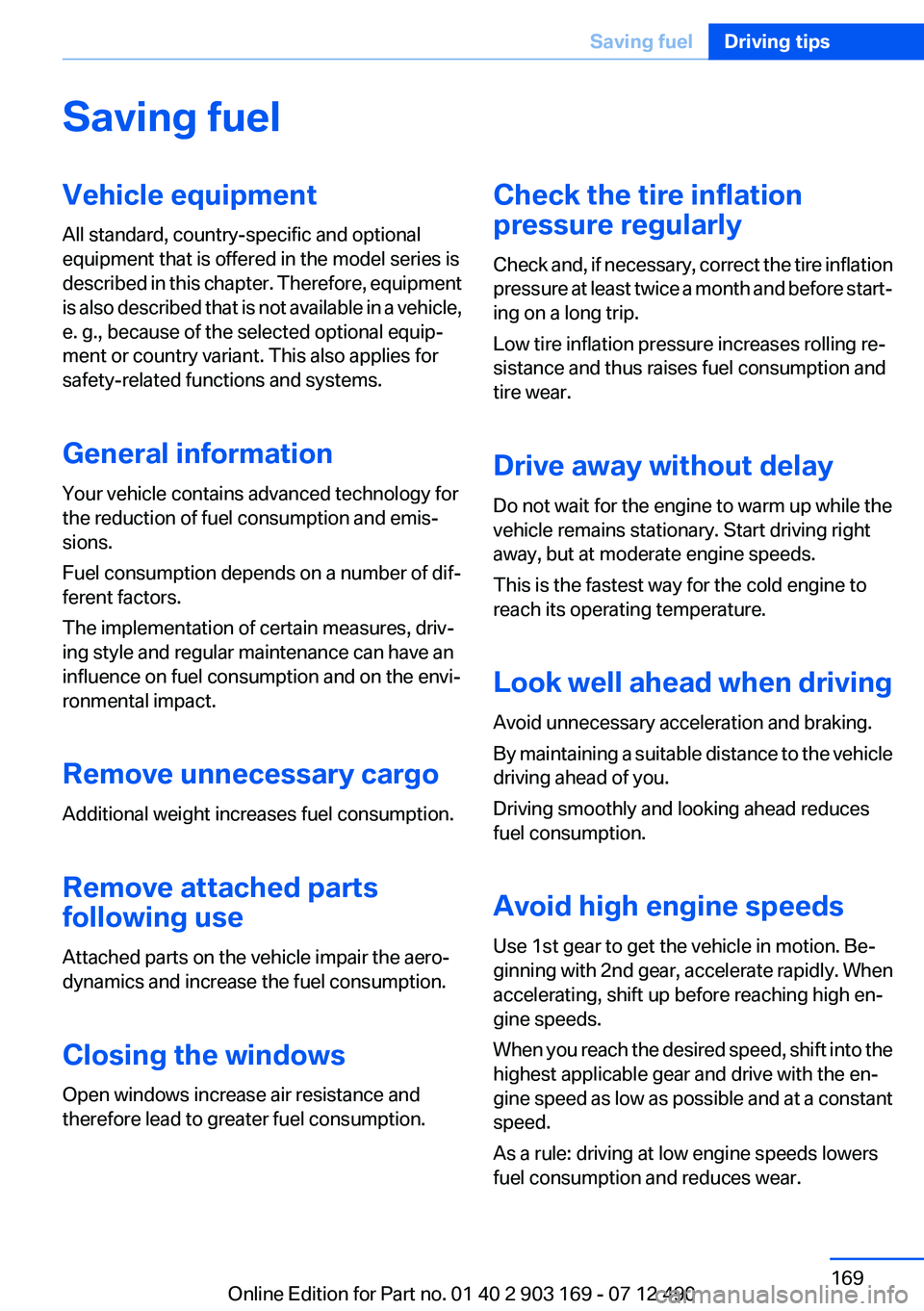
Saving fuelVehicle equipment
All standard, country-specific and optional
equipment that is offered in the model series is
described in this chapter. Therefore, equipment
is also described that is not available in a vehicle,
e. g., because of the selected optional equip‐
ment or country variant. This also applies for
safety-related functions and systems.
General information
Your vehicle contains advanced technology for
the reduction of fuel consumption and emis‐
sions.
Fuel consumption depends on a number of dif‐
ferent factors.
The implementation of certain measures, driv‐
ing style and regular maintenance can have an
influence on fuel consumption and on the envi‐
ronmental impact.
Remove unnecessary cargo
Additional weight increases fuel consumption.
Remove attached parts
following use
Attached parts on the vehicle impair the aero‐
dynamics and increase the fuel consumption.
Closing the windows
Open windows increase air resistance and
therefore lead to greater fuel consumption.Check the tire inflation
pressure regularly
Check and, if necessary, correct the tire inflation
pressure at least twice a month and before start‐
ing on a long trip.
Low tire inflation pressure increases rolling re‐
sistance and thus raises fuel consumption and
tire wear.
Drive away without delay
Do not wait for the engine to warm up while the
vehicle remains stationary. Start driving right
away, but at moderate engine speeds.
This is the fastest way for the cold engine to
reach its operating temperature.
Look well ahead when driving
Avoid unnecessary acceleration and braking.
By maintaining a suitable distance to the vehicle
driving ahead of you.
Driving smoothly and looking ahead reduces
fuel consumption.
Avoid high engine speeds
Use 1st gear to get the vehicle in motion. Be‐
ginning with 2nd gear, accelerate rapidly. When
accelerating, shift up before reaching high en‐
gine speeds.
When you reach the desired speed, shift into the
highest applicable gear and drive with the en‐
gine speed as low as possible and at a constant
speed.
As a rule: driving at low engine speeds lowers
fuel consumption and reduces wear.Seite 169Saving fuelDriving tips169
Online Edition for Part no. 01 40 2 903 169 - 07 12 490
Page 187 of 240
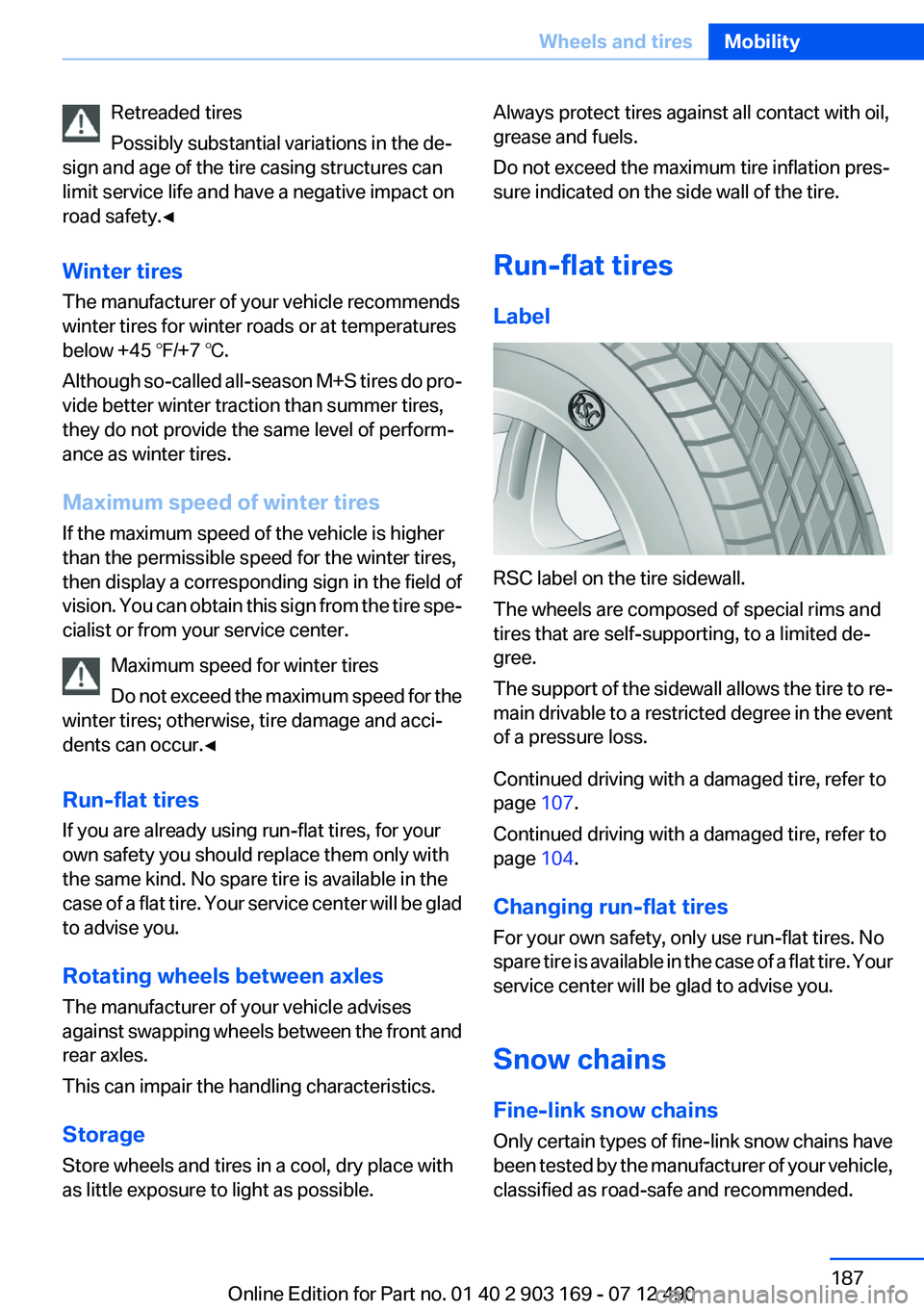
Retreaded tires
Possibly substantial variations in the de‐
sign and age of the tire casing structures can
limit service life and have a negative impact on
road safety.◀
Winter tires
The manufacturer of your vehicle recommends
winter tires for winter roads or at temperatures
below +45 ℉/+7 ℃.
Although so-called all-season M+S tires do pro‐
vide better winter traction than summer tires,
they do not provide the same level of perform‐
ance as winter tires.
Maximum speed of winter tires
If the maximum speed of the vehicle is higher
than the permissible speed for the winter tires,
then display a corresponding sign in the field of
vision. You can obtain this sign from the tire spe‐
cialist or from your service center.
Maximum speed for winter tires
Do not exceed the maximum speed for the
winter tires; otherwise, tire damage and acci‐
dents can occur.◀
Run-flat tires
If you are already using run-flat tires, for your
own safety you should replace them only with
the same kind. No spare tire is available in the
case of a flat tire. Your service center will be glad
to advise you.
Rotating wheels between axles
The manufacturer of your vehicle advises
against swapping wheels between the front and
rear axles.
This can impair the handling characteristics.
Storage
Store wheels and tires in a cool, dry place with
as little exposure to light as possible.Always protect tires against all contact with oil,
grease and fuels.
Do not exceed the maximum tire inflation pres‐
sure indicated on the side wall of the tire.
Run-flat tires
Label
RSC label on the tire sidewall.
The wheels are composed of special rims and
tires that are self-supporting, to a limited de‐
gree.
The support of the sidewall allows the tire to re‐
main drivable to a restricted degree in the event
of a pressure loss.
Continued driving with a damaged tire, refer to
page 107.
Continued driving with a damaged tire, refer to
page 104.
Changing run-flat tires
For your own safety, only use run-flat tires. No
spare tire is available in the case of a flat tire. Your
service center will be glad to advise you.
Snow chains
Fine-link snow chains
Only certain types of fine-link snow chains have
been tested by the manufacturer of your vehicle,
classified as road-safe and recommended.
Seite 187Wheels and tiresMobility187
Online Edition for Part no. 01 40 2 903 169 - 07 12 490
Page 230 of 240
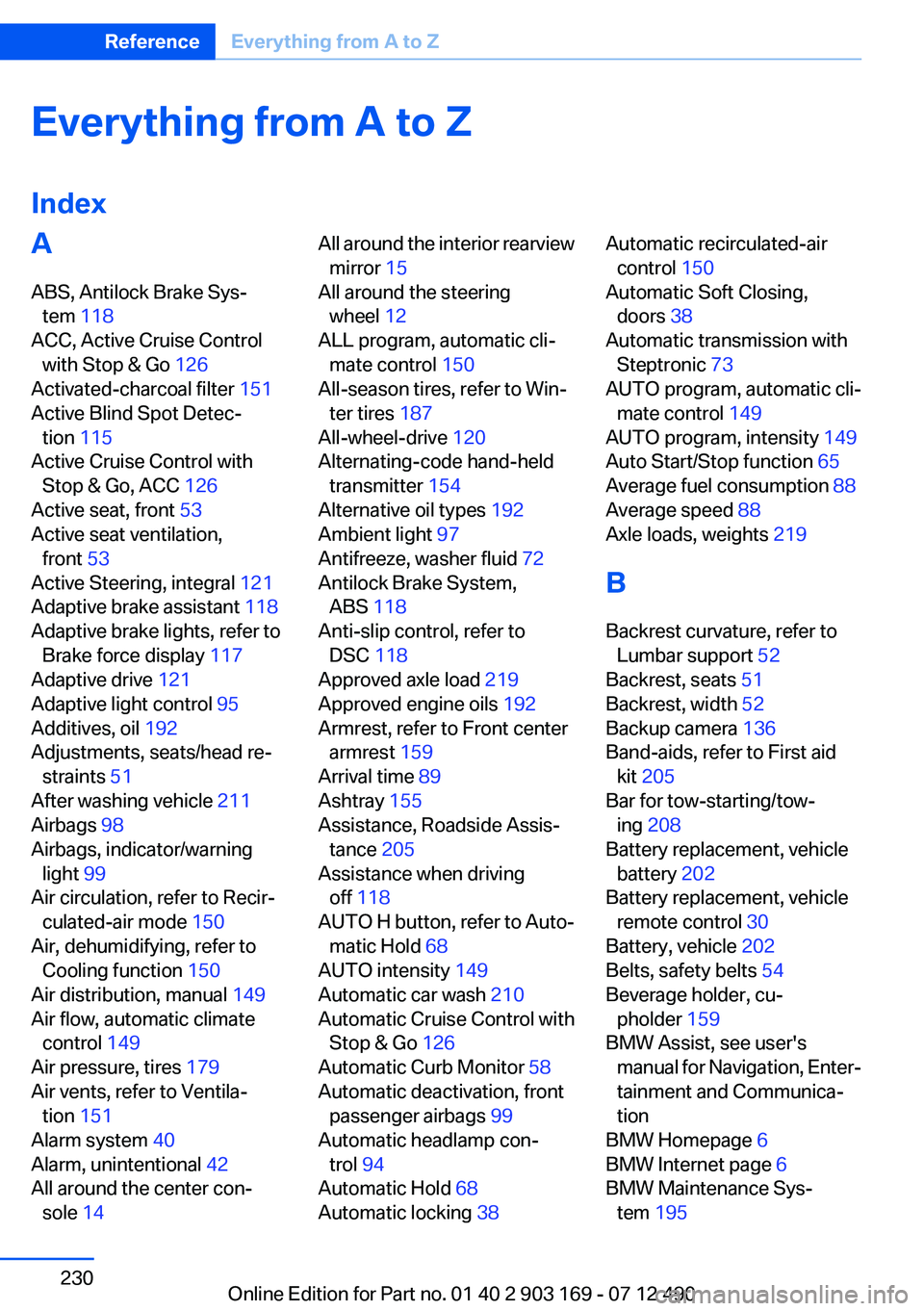
Everything from A to Z
IndexA
ABS, Antilock Brake Sys‐ tem 118
ACC, Active Cruise Control with Stop & Go 126
Activated-charcoal filter 151
Active Blind Spot Detec‐ tion 115
Active Cruise Control with Stop & Go, ACC 126
Active seat, front 53
Active seat ventilation, front 53
Active Steering, integral 121
Adaptive brake assistant 118
Adaptive brake lights, refer to Brake force display 117
Adaptive drive 121
Adaptive light control 95
Additives, oil 192
Adjustments, seats/head re‐ straints 51
After washing vehicle 211
Airbags 98
Airbags, indicator/warning light 99
Air circulation, refer to Recir‐ culated-air mode 150
Air, dehumidifying, refer to Cooling function 150
Air distribution, manual 149
Air flow, automatic climate control 149
Air pressure, tires 179
Air vents, refer to Ventila‐ tion 151
Alarm system 40
Alarm, unintentional 42
All around the center con‐ sole 14 All around the interior rearview
mirror 15
All around the steering wheel 12
ALL program, automatic cli‐ mate control 150
All-season tires, refer to Win‐ ter tires 187
All-wheel-drive 120
Alternating-code hand-held transmitter 154
Alternative oil types 192
Ambient light 97
Antifreeze, washer fluid 72
Antilock Brake System, ABS 118
Anti-slip control, refer to DSC 118
Approved axle load 219
Approved engine oils 192
Armrest, refer to Front center armrest 159
Arrival time 89
Ashtray 155
Assistance, Roadside Assis‐ tance 205
Assistance when driving off 118
AUTO H button, refer to Auto‐ matic Hold 68
AUTO intensity 149
Automatic car wash 210
Automatic Cruise Control with Stop & Go 126
Automatic Curb Monitor 58
Automatic deactivation, front passenger airbags 99
Automatic headlamp con‐ trol 94
Automatic Hold 68
Automatic locking 38 Automatic recirculated-air
control 150
Automatic Soft Closing, doors 38
Automatic transmission with Steptronic 73
AUTO program, automatic cli‐ mate control 149
AUTO program, intensity 149
Auto Start/Stop function 65
Average fuel consumption 88
Average speed 88
Axle loads, weights 219
B
Backrest curvature, refer to Lumbar support 52
Backrest, seats 51
Backrest, width 52
Backup camera 136
Band-aids, refer to First aid kit 205
Bar for tow-starting/tow‐ ing 208
Battery replacement, vehicle battery 202
Battery replacement, vehicle remote control 30
Battery, vehicle 202
Belts, safety belts 54
Beverage holder, cu‐ pholder 159
BMW Assist, see user's manual for Navigation, Enter‐
tainment and Communica‐
tion
BMW Homepage 6
BMW Internet page 6
BMW Maintenance Sys‐ tem 195 Seite 230ReferenceEverything from A to Z230
Online Edition for Part no. 01 40 2 903 169 - 07 12 490
Page 233 of 240
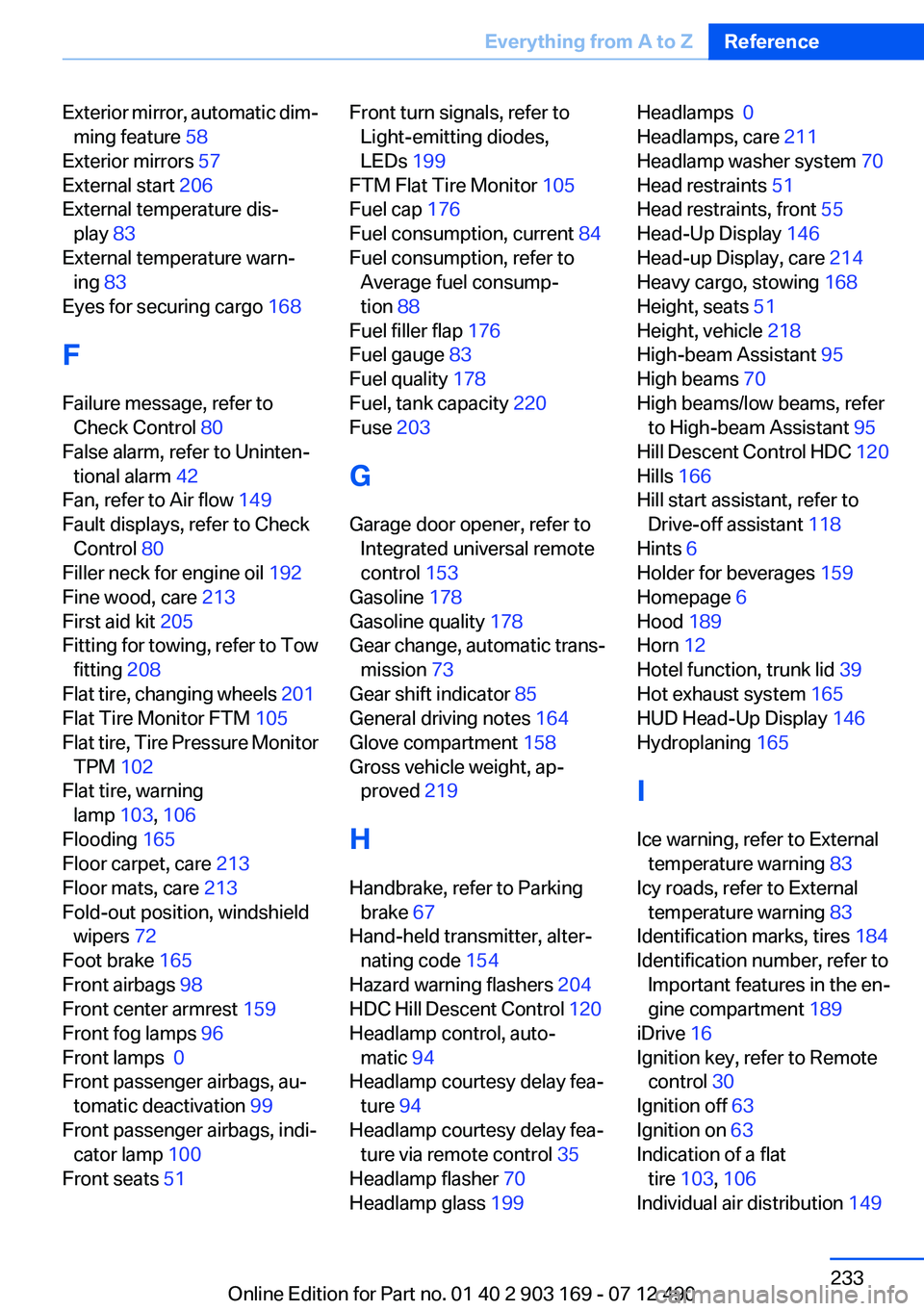
Exterior mirror, automatic dim‐ming feature 58
Exterior mirrors 57
External start 206
External temperature dis‐ play 83
External temperature warn‐ ing 83
Eyes for securing cargo 168
F
Failure message, refer to Check Control 80
False alarm, refer to Uninten‐ tional alarm 42
Fan, refer to Air flow 149
Fault displays, refer to Check Control 80
Filler neck for engine oil 192
Fine wood, care 213
First aid kit 205
Fitting for towing, refer to Tow fitting 208
Flat tire, changing wheels 201
Flat Tire Monitor FTM 105
Flat tire, Tire Pressure Monitor TPM 102
Flat tire, warning lamp 103, 106
Flooding 165
Floor carpet, care 213
Floor mats, care 213
Fold-out position, windshield wipers 72
Foot brake 165
Front airbags 98
Front center armrest 159
Front fog lamps 96
Front lamps 0
Front passenger airbags, au‐ tomatic deactivation 99
Front passenger airbags, indi‐ cator lamp 100
Front seats 51 Front turn signals, refer to
Light-emitting diodes,
LEDs 199
FTM Flat Tire Monitor 105
Fuel cap 176
Fuel consumption, current 84
Fuel consumption, refer to Average fuel consump‐
tion 88
Fuel filler flap 176
Fuel gauge 83
Fuel quality 178
Fuel, tank capacity 220
Fuse 203
G
Garage door opener, refer to Integrated universal remote
control 153
Gasoline 178
Gasoline quality 178
Gear change, automatic trans‐ mission 73
Gear shift indicator 85
General driving notes 164
Glove compartment 158
Gross vehicle weight, ap‐ proved 219
H
Handbrake, refer to Parking brake 67
Hand-held transmitter, alter‐ nating code 154
Hazard warning flashers 204
HDC Hill Descent Control 120
Headlamp control, auto‐ matic 94
Headlamp courtesy delay fea‐ ture 94
Headlamp courtesy delay fea‐ ture via remote control 35
Headlamp flasher 70
Headlamp glass 199 Headlamps 0
Headlamps, care 211
Headlamp washer system 70
Head restraints 51
Head restraints, front 55
Head-Up Display 146
Head-up Display, care 214
Heavy cargo, stowing 168
Height, seats 51
Height, vehicle 218
High-beam Assistant 95
High beams 70
High beams/low beams, refer to High-beam Assistant 95
Hill Descent Control HDC 120
Hills 166
Hill start assistant, refer to Drive-off assistant 118
Hints 6
Holder for beverages 159
Homepage 6
Hood 189
Horn 12
Hotel function, trunk lid 39
Hot exhaust system 165
HUD Head-Up Display 146
Hydroplaning 165
I
Ice warning, refer to External temperature warning 83
Icy roads, refer to External temperature warning 83
Identification marks, tires 184
Identification number, refer to Important features in the en‐
gine compartment 189
iDrive 16
Ignition key, refer to Remote control 30
Ignition off 63
Ignition on 63
Indication of a flat tire 103 , 106
Individual air distribution 149 Seite 233Everything from A to ZReference233
Online Edition for Part no. 01 40 2 903 169 - 07 12 490
Page 234 of 240
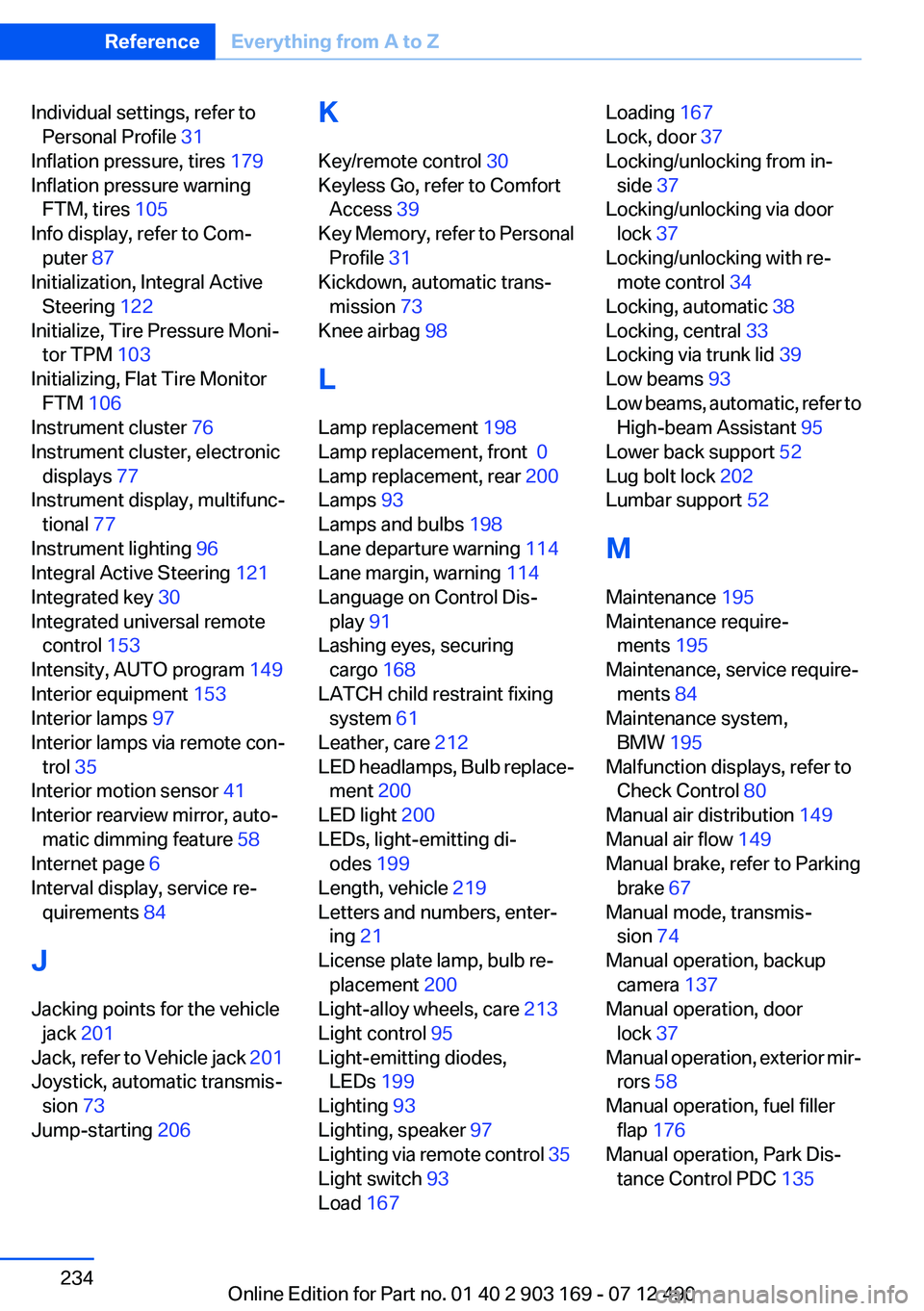
Individual settings, refer toPersonal Profile 31
Inflation pressure, tires 179
Inflation pressure warning FTM, tires 105
Info display, refer to Com‐ puter 87
Initialization, Integral Active Steering 122
Initialize, Tire Pressure Moni‐ tor TPM 103
Initializing, Flat Tire Monitor FTM 106
Instrument cluster 76
Instrument cluster, electronic displays 77
Instrument display, multifunc‐ tional 77
Instrument lighting 96
Integral Active Steering 121
Integrated key 30
Integrated universal remote control 153
Intensity, AUTO program 149
Interior equipment 153
Interior lamps 97
Interior lamps via remote con‐ trol 35
Interior motion sensor 41
Interior rearview mirror, auto‐ matic dimming feature 58
Internet page 6
Interval display, service re‐ quirements 84
J
Jacking points for the vehicle jack 201
Jack, refer to Vehicle jack 201
Joystick, automatic transmis‐ sion 73
Jump-starting 206 K
Key/remote control 30
Keyless Go, refer to Comfort Access 39
Key Memory, refer to Personal Profile 31
Kickdown, automatic trans‐ mission 73
Knee airbag 98
L
Lamp replacement 198
Lamp replacement, front 0
Lamp replacement, rear 200
Lamps 93
Lamps and bulbs 198
Lane departure warning 114
Lane margin, warning 114
Language on Control Dis‐ play 91
Lashing eyes, securing cargo 168
LATCH child restraint fixing system 61
Leather, care 212
LED headlamps, Bulb replace‐ ment 200
LED light 200
LEDs, light-emitting di‐ odes 199
Length, vehicle 219
Letters and numbers, enter‐ ing 21
License plate lamp, bulb re‐ placement 200
Light-alloy wheels, care 213
Light control 95
Light-emitting diodes, LEDs 199
Lighting 93
Lighting, speaker 97
Lighting via remote control 35
Light switch 93
Load 167 Loading 167
Lock, door 37
Locking/unlocking from in‐ side 37
Locking/unlocking via door lock 37
Locking/unlocking with re‐ mote control 34
Locking, automatic 38
Locking, central 33
Locking via trunk lid 39
Low beams 93
Low beams, automatic, refer to High-beam Assistant 95
Lower back support 52
Lug bolt lock 202
Lumbar support 52
M
Maintenance 195
Maintenance require‐ ments 195
Maintenance, service require‐ ments 84
Maintenance system, BMW 195
Malfunction displays, refer to Check Control 80
Manual air distribution 149
Manual air flow 149
Manual brake, refer to Parking brake 67
Manual mode, transmis‐ sion 74
Manual operation, backup camera 137
Manual operation, door lock 37
Manual operation, exterior mir‐ rors 58
Manual operation, fuel filler flap 176
Manual operation, Park Dis‐ tance Control PDC 135 Seite 234ReferenceEverything from A to Z234
Online Edition for Part no. 01 40 2 903 169 - 07 12 490
Page 236 of 240
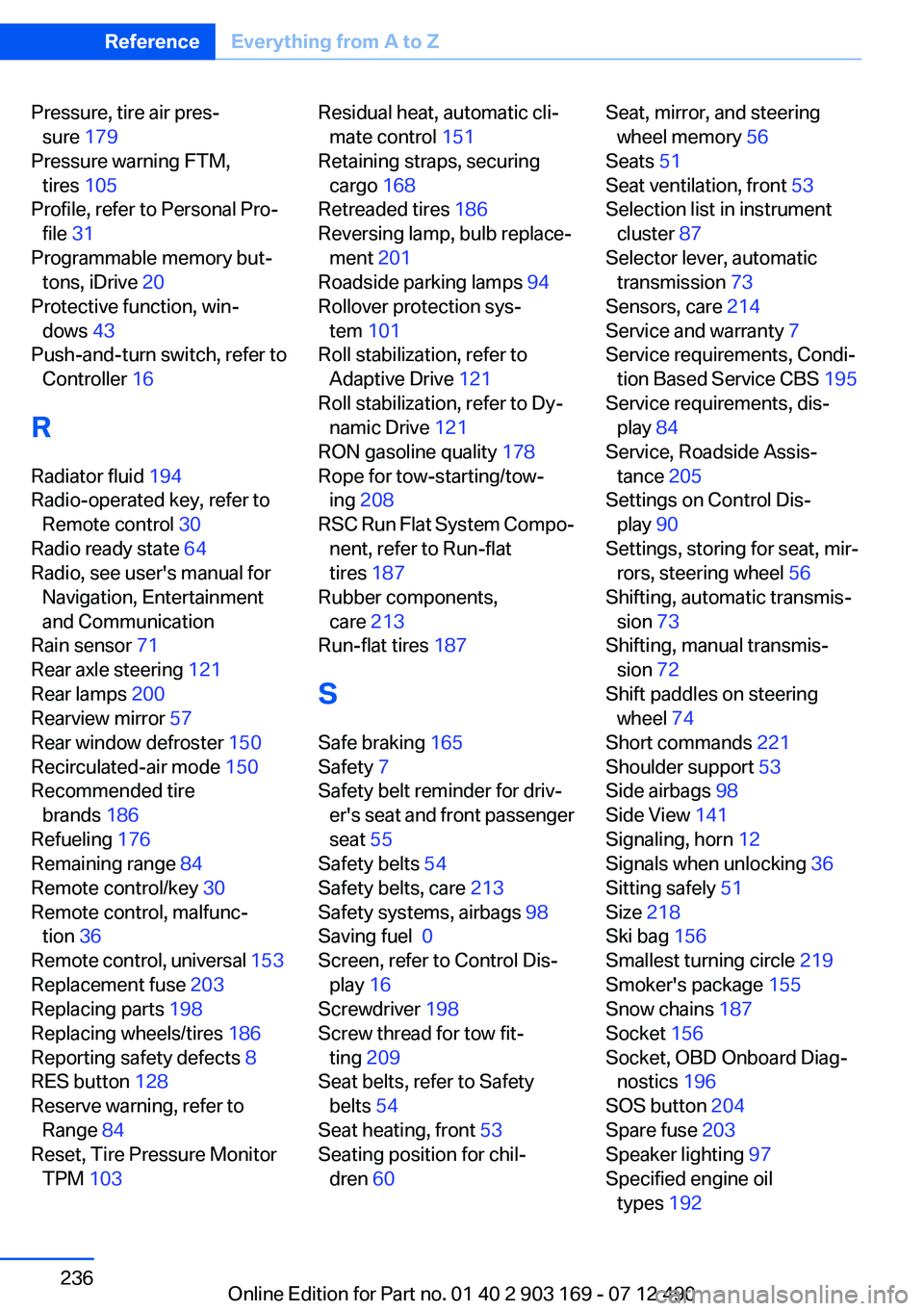
Pressure, tire air pres‐sure 179
Pressure warning FTM, tires 105
Profile, refer to Personal Pro‐ file 31
Programmable memory but‐ tons, iDrive 20
Protective function, win‐ dows 43
Push-and-turn switch, refer to Controller 16
R
Radiator fluid 194
Radio-operated key, refer to Remote control 30
Radio ready state 64
Radio, see user's manual for Navigation, Entertainment
and Communication
Rain sensor 71
Rear axle steering 121
Rear lamps 200
Rearview mirror 57
Rear window defroster 150
Recirculated-air mode 150
Recommended tire brands 186
Refueling 176
Remaining range 84
Remote control/key 30
Remote control, malfunc‐ tion 36
Remote control, universal 153
Replacement fuse 203
Replacing parts 198
Replacing wheels/tires 186
Reporting safety defects 8
RES button 128
Reserve warning, refer to Range 84
Reset, Tire Pressure Monitor TPM 103 Residual heat, automatic cli‐
mate control 151
Retaining straps, securing cargo 168
Retreaded tires 186
Reversing lamp, bulb replace‐ ment 201
Roadside parking lamps 94
Rollover protection sys‐ tem 101
Roll stabilization, refer to Adaptive Drive 121
Roll stabilization, refer to Dy‐ namic Drive 121
RON gasoline quality 178
Rope for tow-starting/tow‐ ing 208
RSC Run Flat System Compo‐ nent, refer to Run-flat
tires 187
Rubber components, care 213
Run-flat tires 187
S
Safe braking 165
Safety 7
Safety belt reminder for driv‐ er's seat and front passenger
seat 55
Safety belts 54
Safety belts, care 213
Safety systems, airbags 98
Saving fuel 0
Screen, refer to Control Dis‐ play 16
Screwdriver 198
Screw thread for tow fit‐ ting 209
Seat belts, refer to Safety belts 54
Seat heating, front 53
Seating position for chil‐ dren 60 Seat, mirror, and steering
wheel memory 56
Seats 51
Seat ventilation, front 53
Selection list in instrument cluster 87
Selector lever, automatic transmission 73
Sensors, care 214
Service and warranty 7
Service requirements, Condi‐ tion Based Service CBS 195
Service requirements, dis‐ play 84
Service, Roadside Assis‐ tance 205
Settings on Control Dis‐ play 90
Settings, storing for seat, mir‐ rors, steering wheel 56
Shifting, automatic transmis‐ sion 73
Shifting, manual transmis‐ sion 72
Shift paddles on steering wheel 74
Short commands 221
Shoulder support 53
Side airbags 98
Side View 141
Signaling, horn 12
Signals when unlocking 36
Sitting safely 51
Size 218
Ski bag 156
Smallest turning circle 219
Smoker's package 155
Snow chains 187
Socket 156
Socket, OBD Onboard Diag‐ nostics 196
SOS button 204
Spare fuse 203
Speaker lighting 97
Specified engine oil types 192 Seite 236ReferenceEverything from A to Z236
Online Edition for Part no. 01 40 2 903 169 - 07 12 490